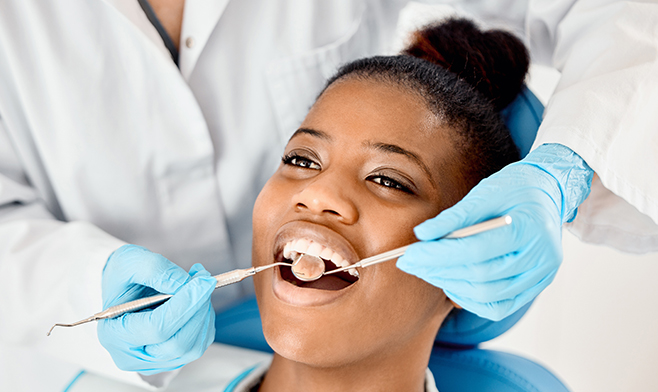If you have gums that are receding, which means you have gums pulling away from a tooth or multiple teeth, it’s important to make an appointment with an experienced dental professional. Gum recession can expose the root of teeth, potentially leading to sensitivity, root decay, and unpleasantries like bad breath.
Gum grafting, a periodontal procedure, can help prevent future recession and bone loss as well as improve overall dental health. Here is everything you need to know about gum grafting here at Poway Perio.
What is Gum Grafting?
Gum grafting, also known as gingival grafting or periodontal plastic surgery, is a dental procedure used to treat gum recession. Gum recession occurs when the gum tissue that surrounds and protects the teeth starts to recede or pull away from the tooth, exposing the tooth’s root. This can lead to a variety of dental issues, including tooth sensitivity, an increased risk of tooth decay, and cosmetic concerns.
There are three different techniques for gum grafting: free gingival grafts, connective tissue grafts, and pedicle grafts. Each has its own advantages and indications, depending on the patient’s specific needs.
After the procedure, patients are typically advised to follow a post-operative care regimen that may include oral hygiene instructions, dietary restrictions, and pain management as necessary to facilitate healing.
The Benefits of Gum Grafting
Gum grafting offers several benefits for individuals experiencing gum recession or related dental issues. Some of the key benefits of gum grafting include:
- The most important role of gum grafting is to preserve the underlying bone. Most studies show that gum recession causes deterioration of supporting bone around the root which eventually leads to tooth loss.
- Tooth root protection: By covering exposed tooth roots, gum grafting helps protect them from decay and damage.
- Enhanced gum health: Gum grafting encourages the growth of healthy gum tissue and can improve overall gum health. This can reduce the risk of periodontal disease and other gum-related issues.
- Improves aesthetics: Gum recession can lead to an uneven or “toothy” smile. Gum grafting can enhance the appearance of the gums and teeth.
- Reduced sensitivity: Exposed tooth roots can be sensitive to temperature changes and touch. Grafting can reduce this sensitivity.
- Prevention of further gum recession: Gum grafting can halt or slow down the progression of gum recession, preventing more serious dental issues in the future.
- Long-term results: When performed properly and followed by good oral hygiene practices, gum grafting can provide long-lasting results, helping patients maintain healthy gums and teeth for years to come.
As with any dental treatment, it’s important for individuals experiencing gum recession or other gum-related issues to consult with a dental professional to determine the most appropriate treatment plan for their specific condition.
Gum Grafting Procedure
The procedure for gum grafting involves several steps and is typically performed by a periodontist, a dentist who specializes in gum health. Here’s an overview of the typical process for gum grafting:
Initial Examination & Assessment
The first step is a thorough examination of your oral health, including an assessment of the extent of gum recession and the condition of your gums and teeth. Your dentist or periodontist will discuss your medical history and any concerns you have about your gums and teeth.
Anesthesia
Before the procedure, you’ll receive local anesthesia to numb the area that will be treated. This ensures that you are comfortable and pain-free during the surgery.
Tissue Selection
The next step involves selecting the source of tissue for the graft. There are several options:
- Autogenous: Tissue is harvested from the roof of the mouth (palate).
- Allograft: Human Donor tissue from a tissue bank is used.
- Xeno graft: other species Donor tissue usually bovine (cow).
Graft Placement
The chosen tissue is then surgically placed over the exposed roots areas of gum recession. The graft covers and protects the exposed tooth roots. The graft is secured in place with sutures (stitches) to ensure it stays in position during the healing process.
Healing and Recovery
The graft will integrate with your existing gum tissue and begin to heal over time. You will receive post-operative care instructions from your dentist or periodontist. This may include guidelines for oral hygiene, dietary restrictions, and instructions on how to care for the surgical site. It’s essential to follow these instructions carefully to promote proper healing.
Choosing the Right Gum Grafting Specialist
If you’re having periodontal issues, it’s essential to choose the right gum grafting specialist for your needs. Here at Poway Perio, we are happy to help you fight periodontitis and get your teeth and gums back to good health with a gum grafting procedure.
If you have more questions or would like to book a consultation, we’re happy to discuss your individual situation. Just give us a call at 858-679-0142.





